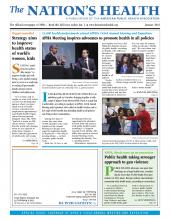Public health advocates can agree that shootings are a huge health issue, considering the more than 33,000 deaths from gun violence in 2014 alone. But gun violence also indicates community-wide health issues, according to researchers.
To a packed crowd at a session at APHA’s 143rd Annual Meeting and Exposition, advocates from the Brady Campaign to Prevent Gun Violence and other public health fields gathered to discuss how to create a public health movement to address gun violence. The tools are already in place, but much work still needs to be done, as 11 children are killed with a gun every day in the U.S., said David Hemenway, professor of Health Policy and Director of the Harvard Injury Control Research Center and APHA member.
Violence begets violence, noted epidemiologist and APHA member Gary Slutkin, MD, but communities can do their parts to mitigate violence. It will take looking at gun violence in new ways — as a public health issue, rather than a criminal justice issue, he said.
“Criminal justice reform won’t be enough,” Slutkin said. “(We need to) go harder at prevention, harder at understanding, harder at care.”
The session touched on many points the Brady Campaign has been touting for years, including at its National Summit with APHA in October in Washington, D.C. The partnership between APHA and the Brady Campaign was facilitated in large part by APHA’s Maternal and Child Health Section’s Gun Violence Prevention Committee, and grew from a joint forum held in March last year. Dan Gross, the campaign’s president, led the charge on the organization’s three key points, calling for policymakers to:
finish the job of expanding “lifesaving Brady background checks” to all gun sales in the U.S.,
stop “bad apple” gun dealers and
“ASK,” part of Asking Saves Kids, or asking families if guns are in their homes before allowing kids to play there.
“This is a new day for the gun violence issue,” Gross told attendees at the summit. “The tipping point for our issue has finally arrived. The American public, everyone, is finally coming together to say, ‘enough.’”
Georges Benjamin, MD, executive director of APHA, said it is time to address gun violence from a prevention approach, rather than responding to violence after the fact. During the summit, Benjamin called on all sectors to join the public health community in partnering for stronger prevention models and practice.

From left, Georges Benjamin, APHA executive director, and Dan Gross, president of the Brady Campaign to Prevent Gun Violence, at the October gun violence summit in D.C. The conversation continued with a session at the Annual Meeting.
Photo courtesy Daniel Greenberg, APHA
“I think we need a private, privately funded research initiative to help us answer a lot of these questions as we go forward so we can be more data-driven,” he said. “Public health can bring these things to the table.”
Obstacles, however, remain. On Dec. 3 — the day after a mass shooting in San Bernardino, California, took the life of 14 health department workers — the U.S. Senate voted down a bipartisan amendment that would have expanded gun sale background checks to gun shows and online sales.
Attitudes influenced by the gun lobby are also a roadblock to stemming the rate of gun violence. According to Brady Campaign data, in 2004, 42 percent of Americans believed a gun made a home safer. By 2014, that number jumped to 63 percent, despite scientific evidence to the contrary. A study published in 2004 in the American Journal of Epidemiology found that families that had purchased a handgun were linked to an elevated risk of both homicide and suicide.
Suicide, in fact, was a major topic of discussion at the summit. Sixty-three percent of gun deaths are suicides — and suicide is often not thought of by the public as a violence or public health issue, noted experts at the summit. Educating the public about the issues and risk factors can save lives, said Liza Gold, MD, a clinical and forensic psychiatrist and distinguished fellow of the American Psychiatric Association.
However, history suggests health advocates can make a difference. Leadership and collaboration has helped to stem the tide of other public health issues, and during the summit, public health leaders heralded their successes. Samuel “Woodie” Kessel, MD, MPH, former assistant surgeon general and pediatrician, touted successes in other issues that affect children, in particular, as examples for gun safety advocates to emulate.
Lead poisoning reduction, car safety and tobacco use prevention have all been extremely successful in the last decades, Kessel said. Not only are they cause for celebration, they are maps to use now.
“We no longer talk about accidents,” Kessel, an APHA member, said. “Accidents are a way of dismissing the issue. We changed it to ‘intentional or unintentional injury.’ In public health, we talk about identifying risk factors.”
To learn more about gun violence prevention, visit www.apha.org/gun-violence and www.bradycampaign.org.
Recent attacks of gun violence hit home for public health workers
APHA reached out to the San Bernardino County Department of Public Health in California in December following a shooting that took the lives of department staff.
On Dec. 2, shooters attacked a health department event at the Inland Regional Center in San Bernardino. Most of the 14 people killed at the center were health department staff who worked on the environmental health services team. APHA Executive Director Georges Benjamin, MD, offered support to the department after the shooting, which he called “senseless.”
In a Dec. 4 editorial published online in The Guardian, Benjamin called for a public health response to combating the U.S. epidemic of gun violence. Among the measures that should be taken are background checks for all gun purchases and legislation from Congress that would support gun violence prevention research, he said.
“Health epidemics don’t end unless we intervene, taking the best science about what does and does not work and using it,” Benjamin said. “The epidemic of intentional gun violence can be reversed with a science-based approach.”
The San Bernardino shooting came less than a week after a gunman attacked a Planned Parenthood clinic in Colorado Springs, Colorado, killing three people. That incident was “an appalling act of violence” that terrorized health care professionals, according to Vicki Cowart, president and CEO of Planned Parenthood Rocky Mountains.
For more on the public health approach to gun violence, visit www.apha.org/gun-violence.
Michele Late contributed to this story.
- Copyright The Nation’s Health, American Public Health Association









